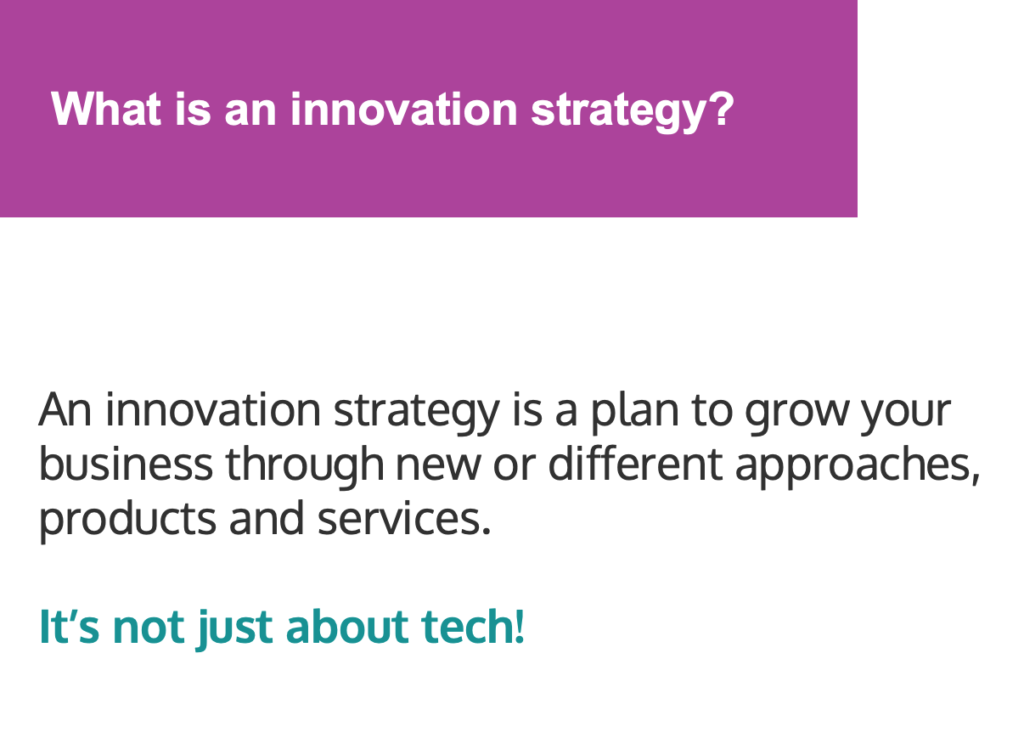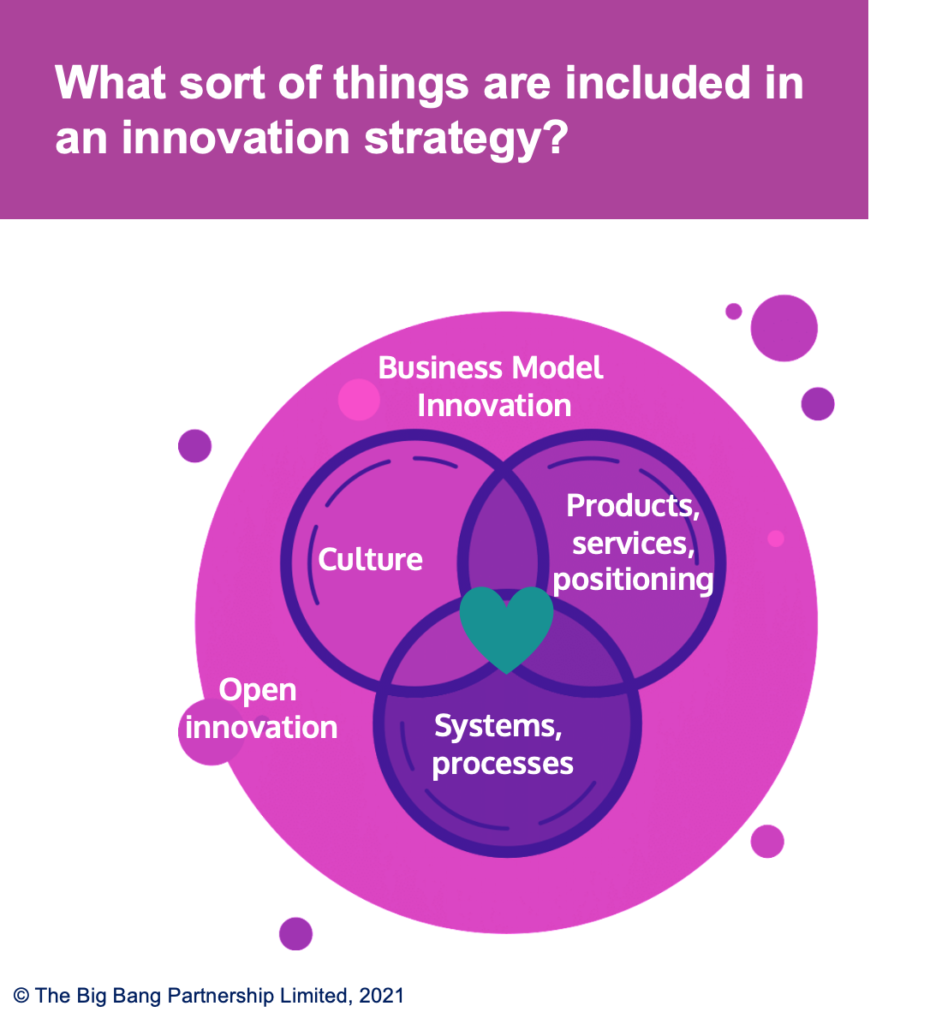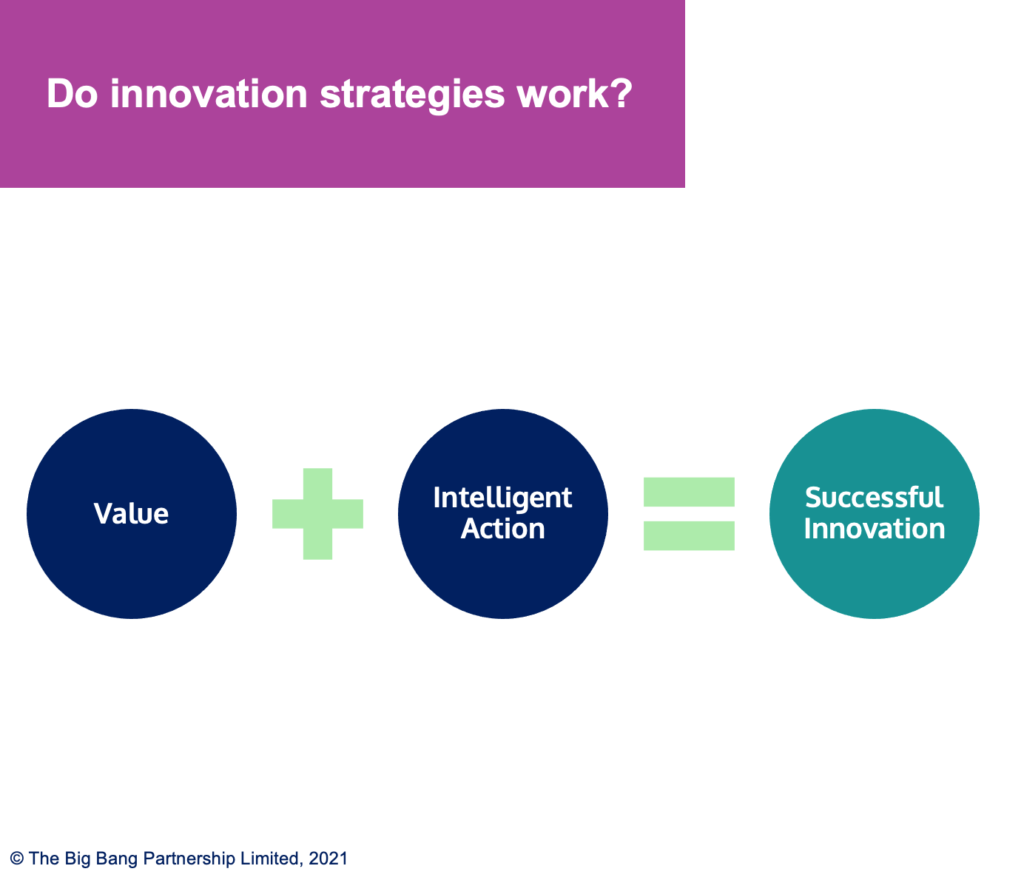Posted in Blog, Entrepreneurship, Innovation, Innovation, Innovation Culture, Intrapreneurship, Launch Your Business by Jo North
Innovation Strategy for Your Business
What is an innovation strategy?
How can an innovation strategy help you drive purpose driven business growth?
How to get started with creating an innovation strategy that’s right for your business?
Have you got so many ideas and things you want to do, but don’t know where to start?
In this article I’m going to be helping you answer these questions as well as address some common pitfalls and critical success factors, so that when you do create your innovation strategy, you know where to start and you’ve got a process to follow.
What is innovation?
Let’s start by defining innovation, because it is one of those words that we use so often.
Innovation is about coming up with great new ideas that make a positive difference to the world, using those ideas and putting them into action to achieve something purposeful.
Innovation isn’t just about the tech. A lot of people associate innovation with only with technology and going digital when it’s about much more.
You can read more about innovation in my article What is business innovation?

What’s included in an innovation strategy?
Some examples of the content included in an innovation strategy are:
- How you are going to develop your products and your service experiences
- The systems and processes your business use
- The company culture you have
When developing your products and services you should consider how you are going to be relevant to the market in the future and continue to stay aligned with what customers are going to need. You also need to consider how you position your products and services, and design your business model to deliver them – business model innovation.
Innovation includes thinking differently about the behind-the-scenes systems and processes you use, for example using automation for speed and better data insights, or decarbonizing your business operations as you work towards becoming a net zero organization.
Cultural innovation means being creative about how you attract retain and engage people, to make sure that people love coming to work, align with the business’ mission, and contribute their best performance. Here are some tips on how to build an innovation culture in your business.

How do you build innovation into your business model?
A business model is how you organize your company to successfully create and monetize the products and services you offer to your customers.
There are different ways of innovating your business model, for example, by licensing, franchising, insourcing or outsourcing, moving on or offline.
Another aspect to consider is open innovation, which means collaborating with other organizations beyond your own. Your business benefits from external innovation input, expanding access to creativity, expertise and resources.

Levels of business innovation
Innovation in business is like an iceberg. Most of it sits unseen below the surface – the multitude of small, incremental innovations designed to drive continuous improvement.
Some innovation is aimed squarely at creating competitive differentiation, i.e. to make a product or service more attractive to customers than the competitors’ offerings. This is often referred to as differential innovation. Examples are laundry detergents that manufacturers claim wash cleaner, or at an even lower temperature than any other; or a restaurant with a quirky menu created to make it stand out from the crowd. Differential innovation is about being better, faster, greener, perhaps even more exciting than the competition.
At the very tip of the innovation iceberg is radical innovation, also known as game changing or disruptive innovation. This level of business innovation is so disruptive that it forces the whole market to change tack.
So please don’t think that having an innovation strategy in your business means that that you’ve got to become the next Uber or Airbnb equivalent in your sector! Only a very small proportion of all successful innovations are so radical. Your innovation strategy can be focused on some of the smaller things that you want to achieve, and on building some fantastic foundations for your business to grow from.
Why does your business need an innovation strategy?
An innovation strategy is a plan to grow your business by taking a fresh, new, purposefully creative approach to product, service, organization and business model development.
Every company, whether you’re a solopreneur, or a multinational organisation, needs an innovation strategy.
Your business needs and innovation strategy because the world around us is constantly changing, meaning that your competitors’ strategies and your customers’ needs change too. To stay successful in business you need to change and align with developments in your market.
You can ‘evolve’ your innovation strategy, making it up as you go along, and there’s nothing wrong with that. But isn’t it better to have a really clear roadmap to take you to where you want to go?
An innovation strategy sets the direction that you want to travel in, giving you a roadmap to help plan your cash flow and the resources that you’ll need on your journey. Your innovation strategy provides you with clear focus for your decision-making and investments.
Your innovation strategy will be even more useful if it is purpose-driven.
What is a purpose-driven innovation strategy?
Businesses that are purpose-driven versus being solely profit-led aim to make a positive difference somehow to the customers that they serve or the communities they are located in. They are in business for reasons that go beyond simply money-making.
Making money in itself isn’t bad. Quite the opposite – money-making can be very positive because, with money, you can do more good. Profits and purpose can go hand in hand.
Businesses that have a purpose-driven innovation strategy, outperform those that are purely profit-led.
According to Deloitte research, purpose-driven companies experience higher market share growth and grow, on average, three times faster than their competitors. Plus, purpose-driven companies have higher employee and customer satisfaction.
I think it’s super important for your innovation strategy to be aligned to the purpose and direction of your business. Remember that purpose doesn’t have to be about solving huge world problems like world hunger or world peace. It can be, but it doesn’t have to be. Your business purpose could be about putting a smile on somebody’s face, making somebody feel a bit better, or have a better day.
Customers value buying from purpose-driven businesses they know that they’re also contributing towards something good.
It benefits employees, too. Doesn’t it feel greater to work for an organization that’s doing something meaningful, beyond just wanting to make a profit?
What are some examples of innovation strategies?
Here are some examples of innovation strategies.
UK Innovation Strategy
Did you know that the UK has got an innovation strategy? In July 2021, ‘Leading The Future by Creating It‘, the UK’s innovation strategy, was released. It sets out the country’s ambitions for an innovation-led economy.
Port of Tyne’s Tyne 2050 strategy
Another publicly available document is the Port of Tyne’s Tyne 2050 innovation strategy. I am really proud to work with the Port of Tyne. Tyne 2050 a great document, which you can download here. It sets out the Port of Tyne’s vision and how the business is going to transform the business and contribute to the region in the years ahead. The strategy includes clear commitments, and that aligns with the 2050 Maritime Strategy that the UK Government created.

Northumbrian Water’s open innovation strategy
Northumbrian Water Group has an open innovation strategy, implemented via their Innovation Festival. They describe it as follows:
“It started in 2017 and has grown over the course of the last four years. The festival has essentially become our idea generation engine, but it is so much more than that. We also use it to make rapid progress on ideas that span organisational boundaries – a years’ worth of work in a week.”
Innovation strategy for small to medium-sized businesses
Through the ‘PAPI’ program, the Product and Process Innovation small to medium-sized business program led by the University of York, I’ve worked with many entrepreneurs to help them shape their innovation strategy for growth. It’s super rewarding to see these businesses go from strength to strength by putting their strategies into action.
How to create a successful innovation strategy
Do innovation strategies actually work? Well, that depends on how well thought-through the innovation strategy is, and how well it is actioned.
To create a successful innovation strategy, make sure that it delivers value for your customers on three levels, by:
- Solving the customers’ problems in the right way. Your innovations need to be useful and achieve what they are designed to deliver.
- Being consistent with the values of your target market, aligning with customers’ perceptions of who they are, what they stand for and who they want to be.
- Achieving products and services that your customers will happily exchange their time, money, and effort to buy into.
Whichever area of innovation you look at, it is important to make sure that you focus on achieving these three types of value.
Value plus intelligent action leads to successful innovation strategy
As well as planning to create value for customers, you’ll also need to take intelligent action. Be smart and select what I call your ‘power moves’, those actions that are give you are going to give you significant progression, to get to where you want to get to.

Part of that intelligent action is making sure that you’re constantly testing things with the people who are going to be on the receiving end, the people that you want to buy or participate in your innovation. Testing all the way through, and then making tweaks and developments as you go, is important, rather than waiting to the end. If you wait too long to test your innovations, you might discover that you’ve taken an unhelpful direction and need to u-turn.
Steps for creating an innovation strategy from scratch
When you’re taking the first steps towards creating your own innovation strategy from scratch, begin by looking outside your business. Take in what is going on in the outside world, identify the changes, trends and developments, and look ahead to future scenarios. Ask yourself questions such as:
- How are people changing behaviours and expectations?
- What’s happening with the economy?
- How is technology changing the industry that you’re in?
- Are there any new regulations that are due to come out?
- What’s happening with climate change and how that might affect how you need to do business?

1. Spot external trends for your innovation strategy
Look at all of the factors that are going on outside your business including looking at trends that you think might be here to stay.
There’s a difference between a fad, which is a short-term craze, and a trend, which is more long lasting and is more sustainable.
Aim for trends rather than fads in most cases, and also look at how your customers’ needs are going to be changing over time, as well as what’s going on with competitors. The aim of this is to really set out the whole landscape of what’s going on in the world around you and how that might create innovation opportunities for you in the future.
2. Be purpose-driven
Once you have reflected on the world around you, work on your answers to questions such as these:
- What do you think the purpose of your business innovation is, in the context of your external environment?
- What difference do you want your business to make to the world around you?
Clearly define your purpose and what you want to achieve with your innovations.
3. Identify specific innovation opportunities
Some opportunity areas to consider for your innovation strategy are elements of your industry that:
- Demonstrate complacency
- Haven’t changed for a long time
- Are creating customer dissatisfaction
- Offer customers little choice
Look for spaces that are ripe for disruption, and consider how you might turn those into an opportunity to do a better job for customers, or users. Innovate in those spaces, and create a game plan.
4. Collaborate to innovate
Throughout the process of developing your innovation strategy it will be invaluable to collaborate. Innovation is a team game, not an activity for lone wolves. Seek out feedback and ideas, continuously revisit and update what you’re doing. Innovation rarely happens in a straight line, you’ll go backwards and forwards. Sometimes the more we learn, the more we realise what we don’t know and collaboration helps with that.
What challenges are there in creating an innovation strategy?
I hear all sorts of objections and reasons why businesses find it challenging to create an innovation strategy, and I understand that it can be challenging to make innovation a success.
Often businesses have lots of great ideas, but face the following challenges.
Time
I work with so many different sorts of businesses, but the one consistent reason for not innovating and not innovating successfully is ‘we just don’t have the time.’
We’re so busy doing the day job, we don’t have time to innovate.
I think we need a mindset shift on this, because if innovation is in the DNA of our business and built into how we think, then it’s just an integral part of our mindset. This means that we will be innovating constantly, always looking for opportunity and picking up on ways to improve. The aim should be to achieve something however small, every single day to take us towards our innovation goals.
Although there’s never really a single, end goal, because when we reach a point, then we need to innovate again -repeatedly. We need to disrupt or be disrupted, and innovate to thrive.
To adapt an old saying do something today that your future business will thank you for. If you do that every day, however small that thing is, it will all add up.
Money
Another challenge can be money: cash flow and funding. There are exceptions, of course, but when we’re innovating, we usually need to invest upfront before we get a return. And that can have implications on cash flow, or create a need for inward investment.
Having an innovation strategy means that you can map out the cash that you’re going to need, and when you think you’re going to need it.
A tip is to always estimate for more time and money to be needed than you originally think, because things usually cost more and take longer.
Build an innovation roadmap and think about how much you might need, when and where you might get any funding from and how, before you need it. It’s always better to start earlier rather than wait until you’re right up against the wire and you need that funding now.
If funding is a concern, remember that there is usually money available for really great ideas. Work up your ideas, make sure you can tell the story of those ideas and that you can communicate them confidently and clearly. Think about the funding sooner rather than later.

Risk
Risk aversion and fear of failure can be a challenge of innovation. But it’s just as risky, if not more so, to stand still.
If you’re not innovating, you’re not moving forward and falling behind your competitors and what your customers want and need from you. So, weigh up the risk.
Look at what you can afford and take small steps. If you’re concerned about the risk, do the minimum possible and test your innovation, learn from it, and then go again. Keep things small, try things, pilot them – you don’t have to go forward with huge launches and massive expense.
Try something small, get a taste for it, see how well it works, and then build it from there.
Perfection
People worry about innovation being perfect, but it never is, and rarely needs to be. Having the mentality of always we’re being in beta helps.
Do your best work, put your best work out there, but remember it doesn’t have to be perfect. And then go again and keep improving from there.
Don’t innovate by striving for perfection in an echo chamber. Make sure you’re constantly getting feedback, and that you are being selective about how you use that feedback. This will reduce your risk and improve your chances of success, too.
Constant change
Some people challenge the point of having a strategy when everything’s always changing.
But, I’m with Winston Churchill: “plans are of little importance, but planning is essential”.
The very act of creating an innovation strategy and stopping to think about what it is you want to do, how you want to do it, and what’s important, will help you move forward, gain clarity and optimize your chances of success.
So yes, things will keep changing. But, you don’t set off on a drive without knowing where you’re headed. And the journey may change. Your sat nav may offer you a different route from the one that you were originally intending to go on. In that case, simply take that that different route, but know that you’re still heading for the destination you want to reach.
Next Steps
If you’d like to know any more about innovation strategy and how to create one for your organization, then please do reach out, I’ll be very happy to jump on a Zoom or Teams call to see how I can help answer your questions.
My purpose is to help you innovate, so that you, your team or organization get to where you want to be.
I’ve got all sorts of resources that can help you with your innovation strategy. Have a look at these free articles and YouTube videos that I’ve created for you.
I hope you’ve found this article useful, thank you for taking the time to read it.

